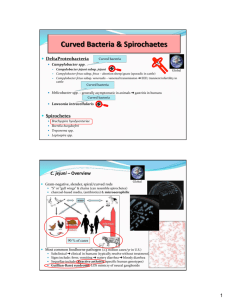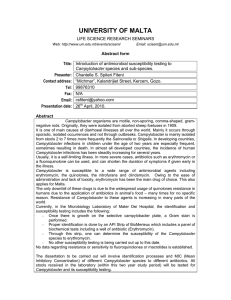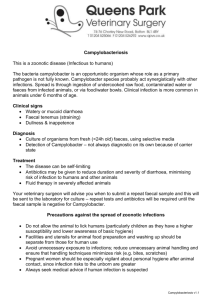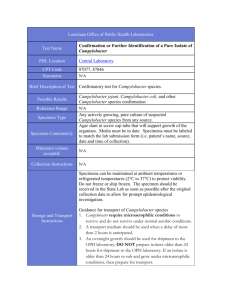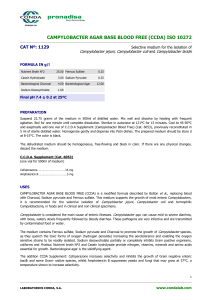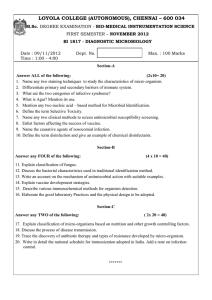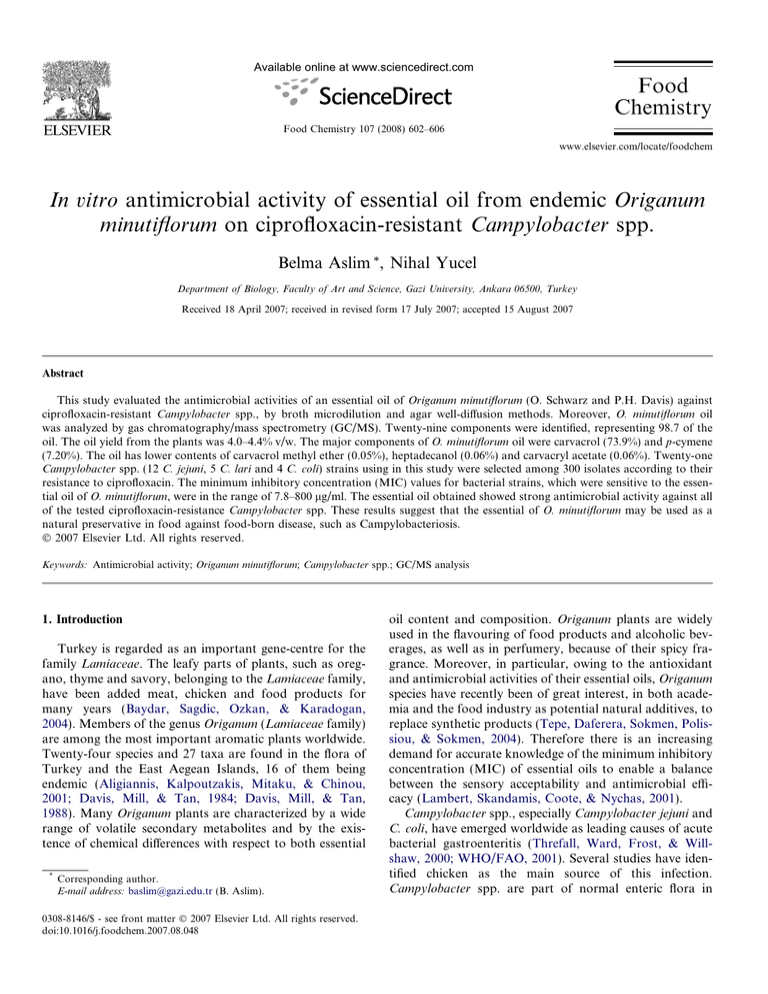
Available online at www.sciencedirect.com
Food
Chemistry
Food Chemistry 107 (2008) 602–606
www.elsevier.com/locate/foodchem
In vitro antimicrobial activity of essential oil from endemic Origanum
minutiflorum on ciprofloxacin-resistant Campylobacter spp.
Belma Aslim *, Nihal Yucel
Department of Biology, Faculty of Art and Science, Gazi University, Ankara 06500, Turkey
Received 18 April 2007; received in revised form 17 July 2007; accepted 15 August 2007
Abstract
This study evaluated the antimicrobial activities of an essential oil of Origanum minutiflorum (O. Schwarz and P.H. Davis) against
ciprofloxacin-resistant Campylobacter spp., by broth microdilution and agar well-diffusion methods. Moreover, O. minutiflorum oil
was analyzed by gas chromatography/mass spectrometry (GC/MS). Twenty-nine components were identified, representing 98.7 of the
oil. The oil yield from the plants was 4.0–4.4% v/w. The major components of O. minutiflorum oil were carvacrol (73.9%) and p-cymene
(7.20%). The oil has lower contents of carvacrol methyl ether (0.05%), heptadecanol (0.06%) and carvacryl acetate (0.06%). Twenty-one
Campylobacter spp. (12 C. jejuni, 5 C. lari and 4 C. coli) strains using in this study were selected among 300 isolates according to their
resistance to ciprofloxacin. The minimum inhibitory concentration (MIC) values for bacterial strains, which were sensitive to the essential oil of O. minutiflorum, were in the range of 7.8–800 lg/ml. The essential oil obtained showed strong antimicrobial activity against all
of the tested ciprofloxacin-resistance Campylobacter spp. These results suggest that the essential of O. minutiflorum may be used as a
natural preservative in food against food-born disease, such as Campylobacteriosis.
Ó 2007 Elsevier Ltd. All rights reserved.
Keywords: Antimicrobial activity; Origanum minutiflorum; Campylobacter spp.; GC/MS analysis
1. Introduction
Turkey is regarded as an important gene-centre for the
family Lamiaceae. The leafy parts of plants, such as oregano, thyme and savory, belonging to the Lamiaceae family,
have been added meat, chicken and food products for
many years (Baydar, Sagdic, Ozkan, & Karadogan,
2004). Members of the genus Origanum (Lamiaceae family)
are among the most important aromatic plants worldwide.
Twenty-four species and 27 taxa are found in the flora of
Turkey and the East Aegean Islands, 16 of them being
endemic (Aligiannis, Kalpoutzakis, Mitaku, & Chinou,
2001; Davis, Mill, & Tan, 1984; Davis, Mill, & Tan,
1988). Many Origanum plants are characterized by a wide
range of volatile secondary metabolites and by the existence of chemical differences with respect to both essential
*
Corresponding author.
E-mail address: baslim@gazi.edu.tr (B. Aslim).
0308-8146/$ - see front matter Ó 2007 Elsevier Ltd. All rights reserved.
doi:10.1016/j.foodchem.2007.08.048
oil content and composition. Origanum plants are widely
used in the flavouring of food products and alcoholic beverages, as well as in perfumery, because of their spicy fragrance. Moreover, in particular, owing to the antioxidant
and antimicrobial activities of their essential oils, Origanum
species have recently been of great interest, in both academia and the food industry as potential natural additives, to
replace synthetic products (Tepe, Daferera, Sokmen, Polissiou, & Sokmen, 2004). Therefore there is an increasing
demand for accurate knowledge of the minimum inhibitory
concentration (MIC) of essential oils to enable a balance
between the sensory acceptability and antimicrobial efficacy (Lambert, Skandamis, Coote, & Nychas, 2001).
Campylobacter spp., especially Campylobacter jejuni and
C. coli, have emerged worldwide as leading causes of acute
bacterial gastroenteritis (Threfall, Ward, Frost, & Willshaw, 2000; WHO/FAO, 2001). Several studies have identified chicken as the main source of this infection.
Campylobacter spp. are part of normal enteric flora in
B. Aslim, N. Yucel / Food Chemistry 107 (2008) 602–606
animals (chicken, pigs and cattle) and can be transmitted to
humans through contaminated foods (Atanassova & Ring,
1999; Dominguez, Gomez, & Zumalacarregui, 2002). Most
Campylobacter enteric infections are self-limited and do not
require antimicrobial drug treatment. However, severe or
long-lasting infections do occur and may justify antimicrobial drug therapy. In these cases, erythromycin or fluoroquinolones (e.g. ciprofloxacin) are often the drug of
choice (Engberg, Aarestrup, Taylor, Gerner-Smidt, &
Nachamkin, 2001). But, antimicrobial resistance, among
Campylobacter spp., to drugs used in the treatment of
human infection is increasing. It is not surprising, therefore, that several countries have reported a rise in ciprofloxacin-resistant C. jejuni in human infections (Gaudreau
& Gilbert, 2003). Similarly, there has been an increase in
the prevalence of ciprofloxacin-resistant C. jejuni in human
infections, emphasizing the potential to acquire gastroenteritis due to ciprofloxacin-resistant Campylobacter from
consumption of chicken. (Endtz et al., 1991). Furthermore,
some studies have demonstrated an association between
ciprofloxacin-resistant Campylobacter infections and a
longer duration of illness (Engberg, Neimann, Moller Nielsen, Aarestrup, & Fussing, 2004; Nelson et al., 2004). This
situation has forced scientists to search for new antimicrobial substances from various sources, such as medical
plants (S
ß ahin et al., 2003).
In the literature, there are several studies on antimicrobial activity and the essential oil composition of Origanum
species, whereas the antimicrobial activity of the essential
oil of Origanum minutiflorum, against ciprofloxacin-resistant Campylobacter spp., has never before been studied.
Especially, wild oregano (O. minutiflorum) is endemic in
Turkey, and so is of special importance for the study.
The aims of this study were (i) to investigate the antimicrobial activity of the essential oil of O. minutiflorum by broth
microdilution and agar well-diffusion methods against ciprofloxacin-resistant Campylobacter spp. and (ii) to determine the chemical composition of its hydro-distilled
essential oil by GC/MS.
2. Materials and methods
2.1. Plant materials
O. minutiflorum plants were collected during the flowering stage in September, 2004, on Sögüt mountain (elevation
1684 m), Sütcßüler-Isparta, where it is endemic. The identification of plant materials was confirmed by a plant taxonomist, Prof. Dr. Hayri Duman, in the Department of
Biology, Gazi University, Ankara, Turkey.
603
The EO was stored in the dark at 4 °C prior to further
analysis.
2.3. Test microorganisms, isolation and preparation of
inocula
Twenty-one Campylobacter spp. (12 C. jejuni, 5 C. lari
and 4 C. coli) strains were selected among 300 isolates
according to their resistance to ciprofloxacin. These strains
were isolated from different parts of each of the carcasses:
body or cavity. Twenty-five grams from each sample, were
placed in 225 ml of pre-enrichment broth (Lab M, Lab 135)
in sterile plastic bags for 4 h at 37 °C and 20 h at 42 °C.
Following pre-enrichment, 100 ll of the pre-enrichment
broth were cultured on Campylobacter blood-free agar,
containing CCD-agar (charcoal cefoperazone deoxyholate
agar) (Lab M, Lab 112 containing vancomycin, polimyxin
and trimethoprim). CCD-agar plates were incubated at
42 °C for 48 h in a microaerobic atmosphere, using gasgenerating sachets (Oxoid BR 038). Campylobacter species
were identified by their morphological and Gram stain
characteristics (Adesiyum, 1993; Fraser, Chandan, Yamazaki, Brooks, & Garcia, 1992). Isolates were identified as
C. coli, C. jejuni or C. lari, using biotyping (api-CAMPY,
bio-Merieux).
2.4. Determination of minimum inhibitory concentration
(MIC)
Microdilution broth susceptibility assay was used (Koneman, Allen, Janda, Scherckenberger, & Winn, 1997). A
stock solution of essential oil was prepared in 10% dimethylsulfoxide (DMSO) and then serial dilutions of essential
oil were made in a concentration range from 7.8 to
800 lg/ml. The 96-well plates were prepared by dispensing,
into each well, 95 ll of Mueller-Hinton broth (MHB),
100 ll of EO and 5 ll of the inoculants. The inoculums
of microorganisms were prepared using 24 h cultures and
suspensions were adjusted to 4 McFarland standard turbidity. The final volume in each well was 200 ll. A positive
control (containing inoculum but no EO) and negative control (containing EO but no inoculum) were included on
each microplate. The contents of the wells were mixed
and the microplates were incubated at 42 °C for 24 h under
microaerophilic conditions (BBL GasPak System). Three
replicates of each microassay were carried out and the
experiment was carried out twice. The MIC was defined
as the lowest concentration of the compounds to inhibit
the growth of microorganisms. The experiment was performed in triplicate.
2.5. Inhibitory effect by the agar well-diffusion method
2.2. Isolation of essential oil (EO)
A dried sample from the aerial parts (leaves, flowers and
steams) of the plant was subjected to water distillation for
3 h in a Clevenger-type apparatus (yield 4.0–4.4% v/w).
The determination of the inhibitory effect of EO on test
bacteria was carried out by the agar diffusion method (Kalemba & Kunicka, 2003). Campylobacter cultures were
grown at 42 °C for 48 h in MHB. The culture suspensions
604
B. Aslim, N. Yucel / Food Chemistry 107 (2008) 602–606
were adjusted by comparing against 4 McFarland. Petri
dishes with 10 ml of MHA were prepared, previously inoculated with 50 ll of the culture suspension. The wells (£
7.0 mm) were made and the EO, diluted in ethanol to the
test concentration (10% and 15%), was added to wells
(25 ll) and same volume (25 ll) of ethanol was used as a
control. The inoculated plates were incubated at 42 °C
for 48 h under anaerobic conditions (BBL GasPak System). After incubation, the diameter of the inhibition zone
was measured with calipers. The measurements were done
basically from the edge of the zone to the edge of the well.
2.6. Gas chromatography/mass spectrometry (GC/MS)
analysis conditions
The chemical composition of the essential oil was analyzed using the GC–MS technique. The mass spectrometer
was Agilent 6890N GC/5973MSD-SCAN in the electron
impact (EI) ionization mode (70 eV) and with an HP5MS capillary column (bonded and cross-linked 5% phenyl-methylpolysiloxene, 30 mm 0.25 mm, coating thickness 0.25 lm) Injector and detector temperatures were set
at 220 °C. The oven temperature was held at 50 °C for
30 min, then programmed to 240 °C at rate of 3 °C/min.
Helium (99.99%) was the carrier gas at a flow rate of
1 ml/min. Diluted samples (1/100 in hexane, v/v) of 1.0 ll
were injected manually (Aligiannis et al., 2001). The identifications of the components were based on the comparison
of their mass spectra with those of Wiley 7N (contains
392086 compounds spectra), Nist 2002 (contains 174948
compounds spectra) and Flavour (contains 419 compounds) spectra Libraries, as well as by comparison of their
retention times.
2.7. Statistical analysis
All experiments were done in triplicate, and mean values
are presented. Statistical analysis was performed on the
data by SPSS 11.0 Bivariate Correlation Analysis (SPSS
Inc., Chicago, Ill.) with statistical significance determined
at P < 0.01. The Pearson rank order correlation test was
used for comparisons both of broth microdilution and agar
well-diffusion methods, of the antimicrobial activity of the
essential oil.
3. Results and discussion
Antimicrobial resistance, in both medicine and agriculture, is recognized by the World Health Organization
(WHO), along with various other national authorities, as
a major emerging problem of public health importance.
Since Campylobacteriosis is transmitted primarily through
food, the presence of antimicrobial-resistant Campylobacter in raw meat products has important public health implications especially in developing countries, where there is
widespread and uncontrolled use of antibiotics (Hart &
Kariuki, 1998). Antimicrobial resistance, particularly
against the fluoroquinolones (e.g. ciprofloxacin) antibiotics, has now emerged globally with thermophilic Campylobacters. Recently, the acceptance of traditional
medicine as an alternative form for health care and the
development of microbial resistance to the available antibiotics have led authors to investigate the antimicrobial
activity of medicinal plants. Our interest is focussed on
the effectiveness of O. minutiflorum essential oil against ciprofloxacin resistance Campylobacter spp.
The percentage composition of the oil of O. minutiflorum is presented in Table 1. Twenty-nine components were
identified, accounting for 98.7% of the oil. The analysis
showed that carvacrol (73.9%) was the main component
in the oil of O. minutiflorum. Other major components were
identified as p-cymene (7.20%), c-terpinene (3.99%) and
borneol (2.41%). The oil has lower contents of carvacrol
methyl ether (0.05%), heptadecanol (0.06%) and carvacryl
acetate (0.06%). Origanum spp. were previously tested on
various pathogenic bacteria. Studies showed that Origanum
scabrun, which contains 75% of carvacrol, had a very high
antibacterial effect against S. aureus and Escherichia coli
(Aligiannis et al., 2001). A recent study has shown that
the essential oil of Origanum vulgare is characterized
principally by phenol constituents, thymol and carvacrol
(24.7 and 14.0% of the total oil, respectively) and by their
two precursors monoterpene hydrocarbons, c-terpinene
Table 1
Chemical composition of O. minutiflorum essential oil
Compounds
RT min
Composition (%)
1. a-Thujene
2. a-Pinene
3. Camphene
4. b-Pinene
5. 1-Octen-3-ol
6. Myrcene
7. a-Phellandrene
8. d-3-Carene
9. a-Terpinene
10. p-Cymene
11. b-Phellandrene
12. 1.8 Cineole
13. b-Ocimene
14. c-Terpinene
15. a-Terpinolene
16. Borneol
17. Terpineol
18. Carvacrol methyl ether
19. Carvone
20. Thymol
21. Carvacrol
22. Carvacryl acetate
23. b-Caryophyllene
24. Aromadendrene
25. a-Humulene
26. Ledene
27. Spathulenol
28. Caryophyllene-oxide
29. Heptadecanol
Total
8.297
8.528
9.083
10.209
10.406
10.891
11.395
11.649
11.937
12.318
12.469
12.572
12.954
13.853
15.171
18.717
19.357
22.376
23.313
24.721
25.582
28.087
29.971
30.738
31.336
33.036
36.247
36.450
53.434
0.90
0.77
0.65
0.18
0.12
0.97
0.17
1.05
0.83
7.20
0.49
0.37
0.11
3.99
0.13
2.41
0.63
0.05
0.13
0.28
73.93
0.06
1.93
0.24
0.10
0.18
0.28
0.51
0.06
98.72
B. Aslim, N. Yucel / Food Chemistry 107 (2008) 602–606
and p-cymene (11.7 and 14.6% of the total oil, respectively)
(Nostro, Blanco, Cannatelli, Flamini, & Morelli, 2004). In
addition, no antimicrobial activity has been reported for pcymene or c-terpinene (Aligiannis et al., 2001; Sivropoulou
et al., 1996). The chemical composition of essential oils
depends on climatic, seasonal, and geographic conditions
(Baydar et al., 2004). Recently, there has been considerable
interest in essential oils from aromatic plants with
antimicrobial activities for controlling pathogens and/or
toxin-producing microorganisms in foods (Alzoreky &
Nakahara, 2003; Valero & Salmeron, 2003). In addition,
their antimicrobial activity depends on the type, composition and concentration of essential oils. Essential oils rich
in phenolic compounds, such as carvacrol, are widely
reported to possess high levels of antimicrobial activity
(Aligiannis et al., 2001; Baydar et al., 2004). The antimicrobial activities of the essential oil of O. minutiflorum against
ciprofloxacin-resistant Campylobacter spp. examined in the
present study and their potency were assessed by the inhibition zone diameter, and MIC values. These results are
given in Table 2. The inhibition zones and MIC values
for Campylobacter spp. strains which were sensitive to the
essential oil of O. minutiflorum, were in the range
10–28 mm (1/10 diluted with ethanol) and 7.8–800 lg/ml,
respectively. The largest inhibition zones produced by the
essential oil were observed with strains 102a and 6t1 of C.
lari (>28 mm). However, the highest inhibitory activity
was against C. lari 102a and 6t1 strains which showed the
Table 2
MIC values of Origanum minutiflorum essential oil against Campylobacter
spp. tested in micro-well dilution assay
Campylobacter spp.
MIC (lg/ml)
lowest MIC (7.8 lg/ml) and largest growth inhibition
halos. The inhibition zones of the essential oil on Campylobacter spp. strains showed a significant correlation with
MIC values (P < 0.01). Several studies have reported the
essential oils effects on Campylobacter strains during recent
years. Freidman, Henika, and Mandrell (2002) studied
plant essential oil (27 oils and 12 compounds) bactericidal
activities against C. jejuni, E. coli, Listeria monocytogenes
and Salmonella enterica. They found that the essential oils
were most active against C. jejuni (Freidman et al., 2002).
On the other hand, C. jejuni was shown to be resistant to
21 essential oils by other researchers (Smith-Palmer, Steward, & Fyfe, 1998). On the other hand, an essential oil of O.
minutiflorum showed effective antimicrobial activity against
all ciprofloxacin-resistance Campylobacter spp. in this
study.
The essential oil of O. minutiflorum can be used as a natural preservative in food against food-born disease and
food spoilage of Campylobacter spp. Essential oils, as antimicrobial agents present two main characteristics: the first
is their natural origin which means more safety for consumers and the second is that they are considered to be
low risk for resistance development by pathogenic microorganisms. Our study may be considered as the first report on
the antimicrobial activity of an essential oil against ciprofloxacin-resistant Campylobacter. We hope that our results
will provide a starting point for investigations designed to
exploit new natural antimicrobials effective against
Campylobacter.
Acknowledgements
Inhibition zone diameter (mm)
1/10
1/15
C. jejuni
118d
121a
116e
113k
117j
6t4
17a
G6
2c
14a
7d
9a
12.5
31.2
62.5
700
125
31.2
62.5
31.2
125
125
700
700
22 ± 1
27 ± 0
25 ± 0
13 ± 1
21 ± 0
28 ± 0
24 ± 0
27 ± 0
20 ± 0
22 ± 0
12 ± 1
13 ± 1
17 ± 1
27 ± 0
21 ± 0
10 ± 1
18 ± 1
28 ± 0
21 ± 0
25 ± 0
17 ± 0
18 ± 0
9±0
11 ± 0
C. lari
6t1
6t5
13t1
102a
114d
7.8
800
500
7.8
31.2
>28
11 ± 0.4
17 ± 0.3
>28
27 ± 0
>28
8±0
15 ± 0
>28
25 ± 0
C. coli
108c
120f
13t5
14b
125
31.2
250
800
22 ± 1
28 ± 0
18 ± 0
10 ± 0
18 ± 1
26 ± 0
16 ± 0
9±0
Values represent
experiments.
605
averages ± standard
deviations
for
triplicate
The authors wish to thank Prof. Dr. Hayri Duman,
Department of Biology, Faculty of Science and Art, University of Gazi, for the identification of the plant material
collected.
References
Adesiyum, A. A. (1993). Prevalence of Listeria spp., Campylobacter spp.,
Yersinia spp. and toxigenic Escherichia coli on meat and seafoods in
Trinidad. Food Microbiology, 10, 395–403.
Aligiannis, N., Kalpoutzakis, E., Mitaku, S., & Chinou, I. B. (2001).
Composition and antimicrobial activity of essential oils of two
Origanum species. Journal of Agriculture and Food Chemistry, 49,
4168–4170.
Alzoreky, N. S., & Nakahara, K. (2003). Antimicrobial activity of extracts
from some edible plants commonly consumed in Asia. International
Journal of Food Microbiology, 80, 223–230.
Atanassova, V., & Ring, C. (1999). Prevalence of Campylobacter spp. in
poultry and poultry meat in Germany. International Journal of Food
Microbiology, 51, 187–190.
Baydar, H., Sagdic, O., Ozkan, G., & Karadogan, T. (2004). Antimicrobial activity and composition of essential oils from Origanum, Thymbra
and Satureja species with commercial importance in Turkey. Food
Control, 15, 169–172.
Davis, P. H., Mill, R. R., & Tan, K. (Eds.). (1988). Flora of Turkey and the
East Aegean Islands (vol. 10, pp. 145). Edinburgh University Press.
Davis, P. H., Mill, R. R., & Tan, K. (Eds.). (1984). Flora of Turkey and the
East Island (vol. 7, pp. 386). Edinburgh University Press.
606
B. Aslim, N. Yucel / Food Chemistry 107 (2008) 602–606
Dominguez, C., Gomez, I., & Zumalacarregui, J. (2002). Prevalence of
Salmonella and Campylobacter in retail chicken meat in Spain.
International Journal of Food Microbiology, 72, 165–168.
Endtz, H., Ruijs, G. J., van Klingeren, B., Jansen, W. H., van Reyden, T.,
Mounton, R., et al. (1991). Quinolone resistance in Campylobacter
isolated from man and poultry following the introduction of fluoroquinolones in veterinary medicine. Journal of Antimicrobial Chemotherapy, 27, 199–208.
Engberg, J., Aarestrup, F. M., Taylor, D. E., Gerner-Smidt, P., &
Nachamkin, I. (2001). Quinolone and macrolide resistance in Campylobacter jejuni and C. coli: Resistance mechanisms and trends in
human isolates. Emerging Infectious Diseases, 7, 24–34.
Engberg, J., Neimann, J., Moller Nielsen, E., Aarestrup, F. M., & Fussing,
V. (2004). Quinolone-resistant Campylobacter infections in Denmark:
risk factors and clinical consequences. Emerging Infectious Diseases,
10, 1056–1063.
Fraser, A. D., Chandan, V., Yamazaki, H., Brooks, B. W., & Garcia, M.
M. (1992). Simple and economical culture of Campylobacter jejuni and
Campylobacter coli in CO2 in most air. International Journal of Food
Microbiology, 15(3–4), 377–382.
Freidman, M., Henika, P. R., & Mandrell, R. E. (2002). Bactercidal
activities of plant essential oils and some of their isolated constituents
against Campylobacter jejuni, E. coli, Listeria monocytogenes and
Salmonella enterica. Journal of Food Protection, 65(10), 1545–1560.
Gaudreau, C., & Gilbert, H. (2003). Antimicrobial resistance of Campylobacter jejuni subsp. jejuni strains isolated from humans in 1998 to
2002 in Montreal, Canada. Antimicrobial Agents Chemotherapy, 47,
2027–2029.
Hart, C. A., & Kariuki, S. (1998). Antimicrobial resistance in developing
countries. British Medical Journal, 317, 647–650.
Kalemba, D., & Kunicka, A. (2003). Antibacterial and antifungal
properties of essential oils. Current Medicinal Chemistry, 10,
813–829.
Koneman, E. W., Allen, S. D., Janda, W. M., Scherckenberger, P. C., &
Winn, W. C. (1997). Color Atlas and Textbook of Diagnostic
Microbiology. Philadelphia: Lippincott-Raven Publisher, pp. 785–800.
Lambert, R. J. W., Skandamis, P. N., Coote, P. J., & Nychas, G. J. E.
(2001). A study of the minimum inhibitory concentration and mode af
action of oregano essential, thymol and carvacrol. Journal of Applied
Microbiology, 91, 453–462.
Nelson, J. M., Smith, K. E., Vugia, D. J., Rabatsky-Her, T., Segler, S. D.,
Kessenborg, H. D., et al. (2004). Prolonged diarrhea due to ciprofloxacin-resistant Campylobacter infection. Journal of Infectious Disease,
190, 1150–1157.
Nostro, A., Blanco, A. R., Cannatelli, M. A., Flamini, V. E. G., Morelli,
I., et al. (2004). Susceptibility of methicillin-resistant staphylococci to
oregano essential oil, carvacrol and thymol. FEMS Microbiology
Letters, 230, 191–195.
S
ß ahin, F., Karaman, I., Güllüce, M., Öğütcßü, H., S
ß engül, M., Adıgüzel,
A., et al. (2003). Evaluation of Antimicrobial Activities of Satureja
hortensis L. Journal of Ethnopharmacology, 87, 61–65.
Sivropoulou, A., Papanicolau, E., Nicolaou, C., Kokkini, S., Lanaras, T.,
& Arsenakis, M. (1996). Antimicrobial and cytotoxic activities of
Origanum essential oils. Journal of Agriculture and Food Chemistry, 44,
1202–1205.
Smith-Palmer, A., Steward, J., & Fyfe, L. (1998). Antimicrobial properties
of plant essential oils and essences against five important food-borne
pathogens. Letters in Applied Microbiology, 26, 118.
Tepe, B., Daferera, D., Sokmen, M., Polissiou, M., & Sokmen, A. (2004).
The in vitro antioxidant and antimicrobial activities of the essential oil
and various extracts of Origanum syriacum L var bavanii. Journal of the
Science of Food Agriculture, 84, 1389–1396.
Threfall, E. J., Ward, L. R., Frost, J. A., & Willshaw, G. A. (2000). The
emergence and spread of antibiotic resistance in food-borne bacteria.
International Journal of Food Microbiology, 62, 1–5.
Valero, M., & Salmeron, M. C. (2003). Antibacterial activity of 11
essential oils against Bacillus cereus in tyndallized carrot carrot broth.
International Journal of Food Microbiology, 85(1–2), 73–81.
WHO/FAO (2001). Hazard identification, hazard characterization and
exposure assessment of Campylobacter spp. in broiler chickens, Draft
Document- Joint FAO/WHO Activities on Risk. Assessment Microbiolial for Hazard Foods, 141.

